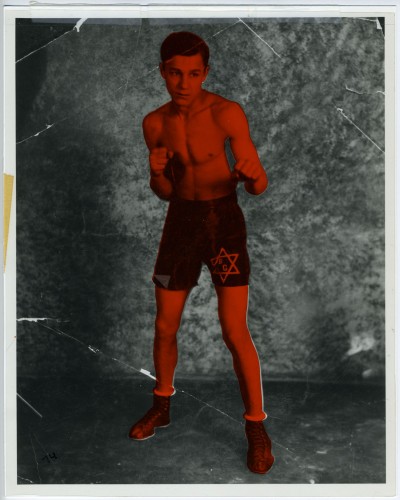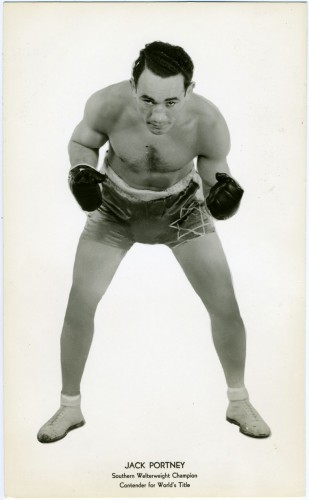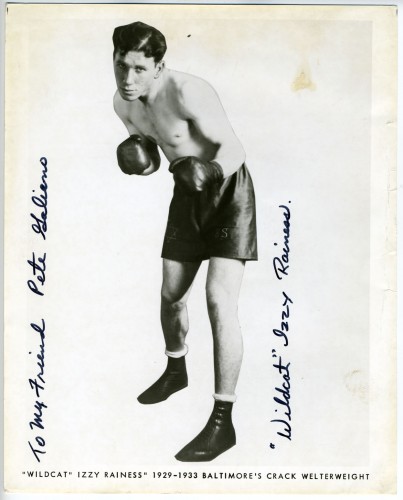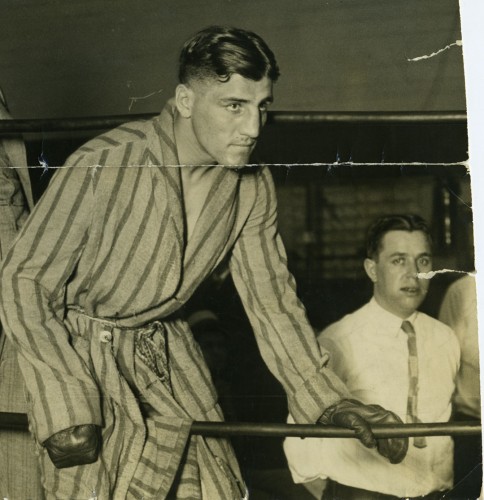The Golden Age of Jewish Boxing
 A blog post by Dr. Deb Weiner.
A blog post by Dr. Deb Weiner.
Lately my head has been in the “interwar era,” as historians refer to the time period between World War I and World War II. In American history, this period is characterized by two major events: Prohibition in the 1920s and the Great Depression of the 1930s. What I recently discovered aboutBaltimoreJewish history is that it can also be characterized as “The Golden Age of Boxing.”
Yes, I know that might seem a bit unexpected. But as usual, the JMM collections tell a fascinating tale:BaltimoreJewish boxers, trainers, managers, promoters, and gamblers played a major role in the sport of boxing during the 1920s and 1930s. Here is just a sampling of what I found in our archives.
Jack Portney grew up on the streets of Baltimore, selling newspapers and “learning to fight to protect his corner from bigger newsboys who wanted his territory,” according to the Baltimore Sun. He entered the ring in 1926 and retired twelve years later with a record of 150 wins and 15 losses. Although he suffered not a single knockout and defeated six former champions, he never got a chance at a title fight in theU.S.—because of discrimination, he claimed: no one would give him a title fight because he was a southpaw. But he did become Southern Welterweight Champion and in 1936, he won the national welterweight championship ofAustralia. After he retired, he started a billiard and bowling supply company that evolved into Jack Portney’s Sporting Goods.
Abraham Sobel was an East Baltimore boy, son of immigrants, with a penchant for daring athletic feats. He would swim from Pratt Street to Federal Hill, retrieving watermelons and cantaloupes that fell from produce boats (the owners would pay him a nickel). He liked to climb the Shot Tower and the steeple of St. Leo’s Church. He became a boxer in the early 1920s and worked out at Freddie Barth’s gym on Fleet Street. He was 5 feet 4 inches tall, weighed 95 pounds, and “was known for being fast and shifty,” according to his Sun obituary. He boxed until 1929, compiling a record of 18 wins, 1 loss, and 1 draw. After boxing, he had a 47-year career as a master plumber.
Leon Luckman began fighting as a teenager in East Baltimore. He entered the ring as an amateur at age fourteen, taking the name Izzy Caplan because he didn’t want his parents to know that he was a boxer. (He chose “Izzy” from “a noted flyweight of the era” and “Caplan” from a world featherweight champion.) A “scrappy, left-handed 112-pound flyweight,” he held the local record for most amateur championships at the city, state, and regional levels. He turned pro in 1933, winning his first ten fights. He later became a fight promoter and owner of a Highlandtown bar.
Izzy Rainess liked to frequent Pimlico Racetrack as a lad, where he earned pocket money by parking cars. He was discovered by a jockey’s agent impressed with his prowess during fights among parking attendants. The agent introduced Rainess to boxing, which he took to immediately, earning the name “Wildcat” because of the way he tore into his opponents. The 5’7”, 145-lb. brawler fought his first pro match in 1932 and proved to be a popular local star, winning 26 of 28 professional fights, with two draws and no defeats.
Harry “Heinie” Blaustein was considered Baltimore’s finest boxing trainer, guiding several boxers to world titles in a career that extended from the 1920s into the 1970s. In the twenties, he became associated with theDundee brothers Vince and Joe, Italian immigrants, who would both become title holders under his care. An “expert boxing instructor and a masterful cornerman,” he was known for the portable apothecary he brought with him to the ring, to tend to his wounded fighters. “I don’t tell nobody what I use,” he once confided. “It’s special preparations my nephew, the pharmacist, prepares for me.”

Benny Goldstein won 81 of his 85 pro bouts before joining the Navy during World War II. After the war he opened a radio repair shop that became 20th Century TV and Appliances.



